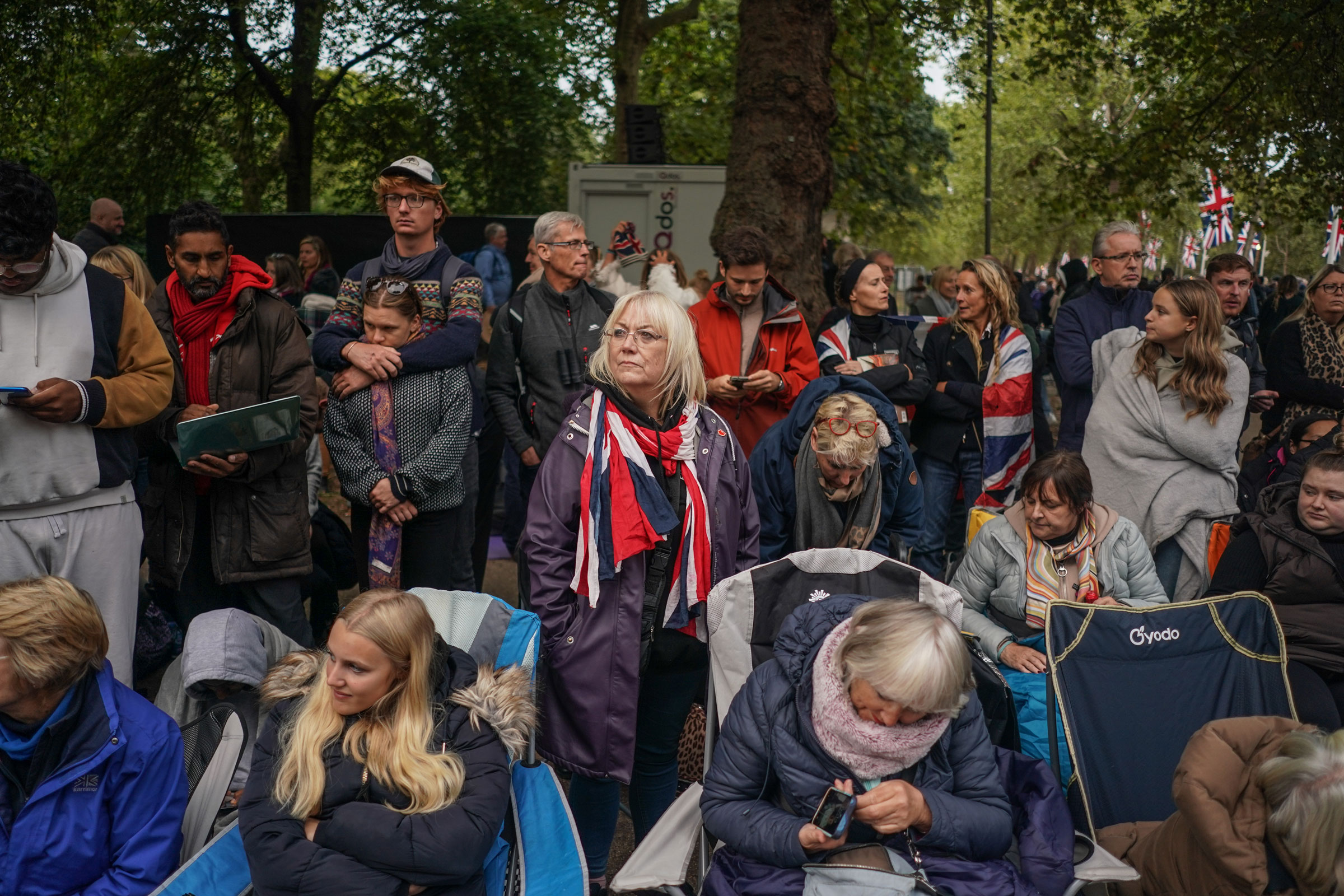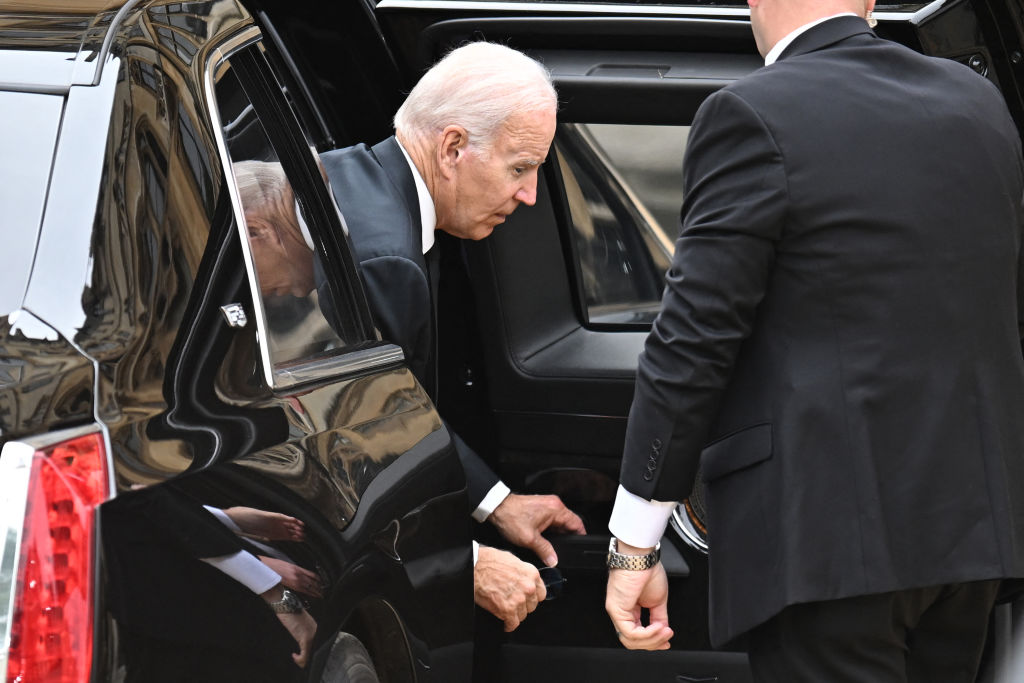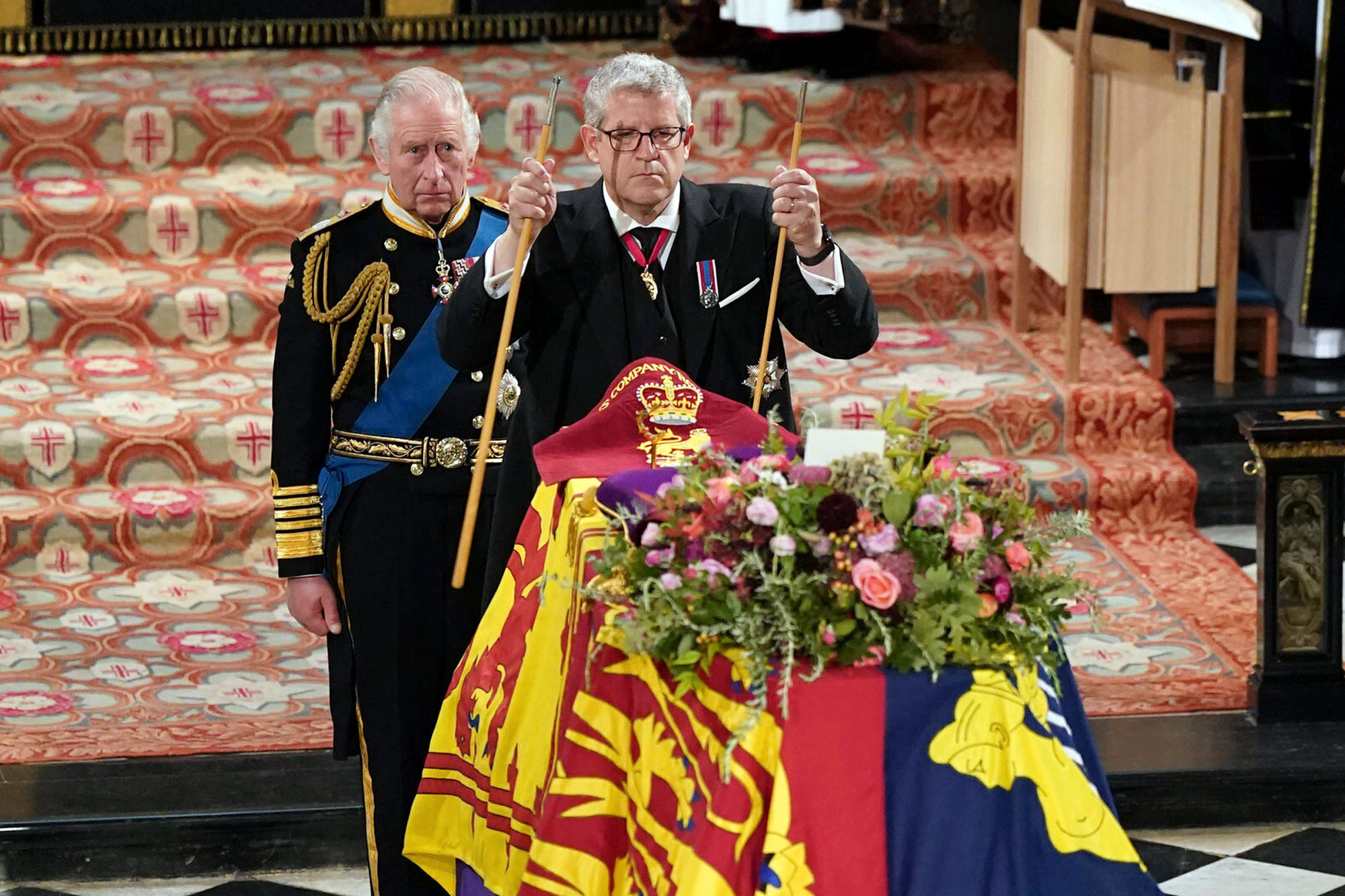The state funeral of Queen Elizabeth II is taking place in the United Kingdom. It is an emotional day for the British public as they bid a final farewell to their beloved monarch, who died on Sept. 8 at the age of 96. The country has come to a standstill, with businesses and schools closed.
By Monday evening, the queen’s coffin was lowered into the vault beneath St. George’s Chapel—just moments after the Imperial State Crown, Orb and Scepter were removed from on top of the coffin.
Earlier, thousands of people lining the streets as the procession headed to WIndsor for the burial, threw flowers towards the vehicle as it departed from Wellington Arch in central London towards Windsor, a historic town some 26 miles (42 kilometers) from London that is the location of Windsor Castle, one of the royal residences. King Charles III and the Queen Consort, as well as other senior royals also traveled by car.
Earlier on, the funeral service was held at Westminster Abbey—the Gothic church in central London where the Queen was crowned in 1953. Her coffin then made its way through Central London in a funeral procession more than a mile long that involved thousands of members of the U.K.’s military.
On top of the coffin was a simple note from King Charles III that read, “in loving and devoted memory—Charles R.”
Planning a state funeral of this magnitude in a little more than a week was a logistical nightmare—one that British officials likened to “arranging 100 state visits all in one go.” But so far, the events have occurred in an exceedingly timely manner—only a couple of minutes behind schedule despite the complicated logistics.
Despite the throngs of people and the heavily-congested streets, the mood outside the Palace of Westminster, where the funeral procession marched past as it headed towards Wellington Arch, was mostly calm. Thousands of people shuffled past one another to watch the procession go by.
Police officers, some of whom had been brought in from far flung parts of the country, helped guide onlookers along. While many mounted buildings and lamp posts to see over the crowds, others brought camping chairs and step-ladders. Some even climbed on the shoulders of their partners and friends.
Here’s what to know about the proceedings.

Who is attending the funeral of Queen Elizabeth II?
The prominent mourners are naturally the Queen’s eldest son and successor, King Charles III, along with the Queen Consort, Charles’ two brothers, Princes Edward and Andrew, and his sister Princess Anne. Eight grandchildren are attending—among them Charles’ sons Prince William and Prince Harry and their respective wives, Catherine the Princess of Wales, and Duchess of Sussex, Meghan Markle. Many other close relatives are among the mourners.
Read more: The Future of the British Monarchy Is More Uncertain Than Ever
Many other royals—from Europe and further afield—are prominent among the more than 2,000 people attending the Westminster Abbey service. They include Belgium’s King Philippe and Queen Mathilde and King Felipe and Queen Letizia of Spain. King Willem-Alexander and Queen Máxima of the Netherlands’ are in attendance, alongside Denmark’s Queen Margarethe II and King Harald V and Queen Sonja of Norway.
Japan’s Emperor Naruhito and Empress Masako are attending, as are Jordan’s King Abdullah, Malaysia’s Yang di-Pertuan Agong (the Sultan Abdullah of Pahang), and Bhutan’s King Jigme Khesar Namgyel Wangchuk.

Among political leaders at the funeral are the current and several former British prime ministers. The U.S. is being represented by President Joe Biden and First Lady Jill Biden. China’s Vice President Wang Qishan is attending, as is Indian President Droupadi Murmu.
South Korea’s President Yoon Suk-yeol is attending, as are Prime Minister Justin Trudeau of Canada, President Jair Bolsonaro of Brazil, President Cyril Ramaphosa of South Africa, Prime Minister Jacinda Ardern of New Zealand, and Prime Minister Anthony Albanese of Australia, among others.
Read more: See Photos of the World Mourning Queen Elizabeth II’s Death
Invitations were reportedly not extended to the leaders of Russia and Belarus, on account of Russian President Vladimir Putin’s Feb. 24 invasion of Ukraine. The junta in Myanmar, which seized power in a 2021 coup, has also not been invited to send a representative.

The the ‘breaking of the wand’ televised for first time ever

For the first time, a ceremonial act known as the breaking of the wand was televised.
Following the end of the last hymn at the committal service, Lord Chamberlain Baron Parker, broke a thin white staff and then put it on the coffin before it was lowered into the Royal Vault.
Historically, the Lord Chamberlain has broken the “Wand of Office” at a monarch’s funeral to signal the end of his service to the monarch; it was last performed seven decades ago after George VI died in 1952. (While the King’s funeral was televised, his committal was not.)
Long ago, the ‘wand’ was used to discipline courtiers by tapping them if they were being loud or inappropriate.
The significance of Prince George and Princess Charlotte at the funeral
The youngest generation of British royals are among the mourners who will have a highly visible place at Queen Elizabeth II’s funeral.
Prince George, 9, and Princess Charlotte, 7, are attending the state funeral—a nod to their enormous significance in the royal family, despite their age.
They are the children of Prince William—the heir apparent to the throne—and Catherine Princess of Wales, and the great-grandchildren of Queen Elizabeth II. Prince Louis, 4, however, is not attending.
With the death of Queen Elizabeth II, Prince George is second in line to the throne, while Princess Charlotte is third.
The youngest royal siblings, however, are expected to be absent at the committal service later in the afternoon at Windsor Castle.

Silence across U.K. for Queen Elizabeth II
The United Kingdom fell silent for two minutes beginning at 11:58 a.m. local time on Monday to honor Queen Elizabeth II. The two minutes of silence began at the funeral for the monarch in Westminster Abbey, but was expected to be widely observed across the nation of 67 million people.
Thousands of people gathered outside the Palace of Westminster fell silent as word got around that the two minutes of silence had begun—slightly behind schedule. For those few moments, the only noises that could be heard were the click of cameras, the occasional hushes among the crowd, and bits of the funeral procession streaming from people’s phones.
The silence ended as quickly as it began when the crowd broke into the national anthem—this time singing “God Save the King” after 70 years of “God Save the Queen.”
As people sang, it was clear that the moment represented for many a palpable sense of transition—from Queen to King and from the end of one age to the start of the next. For most, it was the first time they had sung God Save the King. “It was just a very British moment,” Tina Ferry, 52, from Portsmouth, tells TIME.
Where is the Queen being buried?
Queen Elizabeth is being interred at the late medieval St. George’s Chapel in Windsor Castle, where ten other monarchs lie buried.
The royal vault at the chapel is the final resting place of several members of the British royal family, but the Queen is being interred at an annex known as the King George VI Memorial Chapel. This addition was unveiled at her request in 1969 as a final resting place for her father, whose remains were moved to it from the royal vault.
Read more: The Story Behind TIME’s Queen Elizabeth II Cover
Queen Elizabeth II is to be buried there alongside her father, mother, sister and husband Prince Philip. His remains will be transferred from the royal vault, where they have been held since his death in April.

What is the order of ceremony for Queen Elizabeth’s funeral?
A detailed schedule is available here.
In brief, the Queen’s coffin was taken in a solemn procession from Westminster Hall, where Queen Elizabeth II had been lying in state, to Westminster Abbey for a funeral service at 11:00 a.m. local time (6:00 a.m. ET). The hour-long service was officiated by the Dean of Westminster David Hoyle. U.K. Prime Minister Liz Truss, whose meeting with the Queen was the monarch’s last official engagement, gave a reading.
Read More: How Would Britain Abolish the Monarchy?
The two-minute silence across the U.K. marked the end of the service, along with a reveille, the national anthem, and a royal piper playing a lament.
A gun-carriage is taking the coffin throughout the streets of London, arriving at Wellington Arch, Hyde Park, at 1:00 p.m. (8:00 a.m. ET). From there, a hearse brings the coffin to Windsor for internment.
Over 800 mourners are to attend the committal service, followed by a private burial at the King George VI Memorial Chapel at 7:30 p.m. (1:30 p.m. ET).
—With reporting by Yasmeen Serhan / London
More Must-Reads from TIME
- Caitlin Clark Is TIME's 2024 Athlete of the Year
- Where Trump 2.0 Will Differ From 1.0
- Is Intermittent Fasting Good or Bad for You?
- The 100 Must-Read Books of 2024
- Column: If Optimism Feels Ridiculous Now, Try Hope
- The Future of Climate Action Is Trade Policy
- FX’s Say Nothing Is the Must-Watch Political Thriller of 2024
- Merle Bombardieri Is Helping People Make the Baby Decision
Write to Sanya Mansoor at sanya.mansoor@time.com